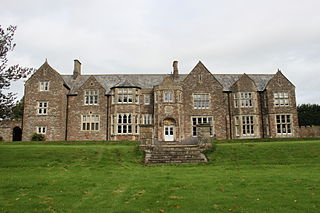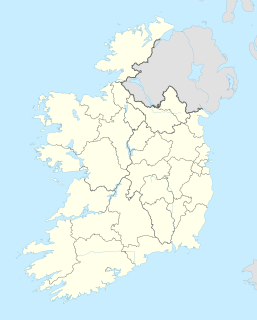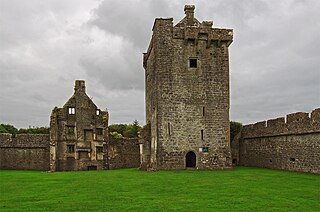
Ross Castle is a 15th-century tower house and keep on the edge of Lough Leane, in Killarney National Park, County Kerry, Ireland. It is the ancestral home of the Chiefs of the Clan O'Donoghue, later associated with the Brownes of Killarney.

Kilchurn Castle is a ruined structure on a rocky peninsula at the northeastern end of Loch Awe, in Argyll and Bute, Scotland. It was first constructed in the mid-15th century as the base of the Campbells of Glenorchy, who extended both the castle and their territory in the area over the next 150 years. After the Campbells became Earls of Breadalbane and moved to Taymouth Castle, Kilchurn fell out of use and was in ruins by 1770. It is now in the care of Historic Environment Scotland and is open to the public in summer.

Blackness Castle is a 15th-century fortress, near the village of Blackness, Scotland, on the south shore of the Firth of Forth.

Dromoland Castle is a castle, located near Newmarket-on-Fergus in County Clare, Ireland. It is operated as a 5-star luxury hotel with a golf course, with its restaurant, the Earl of Thomond, being awarded a Michelin star in 1995, under head chef Jean Baptiste Molinari.

Coity Castle in Glamorgan, Wales, is a Norman castle built by Sir Payn "the Demon" de Turberville, one of the legendary Twelve Knights of Glamorgan supposed to have conquered Glamorgan under the leadership of Robert FitzHamon, Lord of Gloucester. Now in ruins, it stands in the community of Coity Higher near the town of Bridgend, in the County Borough of Bridgend. Very close to the castle is the battlemented parish Church of St Mary the Virgin, which dates from the 14th century.

Sutton Court is an English house remodelled by Thomas Henry Wyatt in the 1850s from a manor house built in the 15th and 16th centuries around a 14th-century fortified pele tower and surrounding buildings. The house has been designated as Grade II* listed building.

Dunasead Castle, sometimes known as Baltimore Castle, is a 17th-century fortified house situated in the town of Baltimore in western County Cork, Ireland. The tower house is built on the site of an earlier Norman-era structure, which itself replaced an earlier Bronze Age ringfort. Traditionally associated with the O'Driscoll family, it was purchased and restored by members of the McCarthy family in the late 1990s, and partially opened to the public from 2005.

Ackergill Tower is located on the coast of Sinclair's Bay, about 4 km north of Wick, Caithness, in northern Scotland. It was built in the early 16th century, and is a category A listed building. The building is a five-storey oblong tower house. The four-storey wing to the rear was added in the early 18th century.

Balcaskie is a 17th-century country house in Fife, Scotland. It lies around 2 km north of St Monans, and is notable chiefly as the home and early work of architect Sir William Bruce.
Patrick Darcy (1598–1668) was an Irish Catholic Confederate and lawyer who wrote the constitution of Confederate Ireland.

Tawstock is a village, civil parish and former manor in North Devon in the English county of Devon, England. The parish is surrounded clockwise from the north by the parishes of Barnstaple, Bishop's Tawton, Atherington, Yarnscombe, Horwood, Lovacott and Newton Tracey and Fremington. In 2001 it had a population of 2,093. The estimated population in June 2019 was 2,372.

Athlone Castle, sometimes known as Adamson Castle, is a castle located in Athlone, County Westmeath, Ireland, dating from the 12th century.
Aghalard Castle is a ruined tower castle south of Castlebar, County Mayo, Ireland. Built in c.1490 by the descendants of the McDonnells of Knocknacloy who had become Gallóglaigh to the Burkes of Mayo. The castle consisted of a three-storey tower with square turrets, enclosed by a bawn. The castle was captured in 1596 by Edward Brabazon, 1st Baron Ardee, Ulick Burke, 3rd Earl of Clanricarde and James Riabhach Darcy, however it was evacuated shortly afterwards upon hearing of the approach of Hugh Roe Ó Donnell. It remained in possession of the McDonnells until bought by Sir Benjamin Guinness in the 19th century.

Shrule Castle is a ruined tower castle near Shrule in County Mayo, Ireland. The castle was built in c.1238, near the Black River at the County Mayo and County Galway border by the de Burgh family. It was given to John de Burgh in 1308 by his father Richard Óg de Burgh, 2nd Earl of Ulster.

Moorstown Castle is a late 15th-century stone structure consisting of an enclosed circular keep near Clonmel, County Tipperary, Ireland.
The High Sheriff of Mayo was the British Crown's judicial representative in County Mayo, Ireland from the 16th century until 1922, when the office was abolished in the new Free State and replaced by the office of Mayo County Sheriff. The sheriff had judicial, electoral, ceremonial and administrative functions and executed High Court Writs. In 1908, an Order in Council made the Lord-Lieutenant the Sovereign's prime representative in a county and reduced the High Sheriff's precedence. However the sheriff retained his responsibilities for the preservation of law and order in the county. The usual procedure for appointing the sheriff from 1660 onwards was that three persons were nominated at the beginning of each year from the county and the Lord Lieutenant then appointed his choice as High Sheriff for the remainder of the year. Often the other nominees were appointed as under-sheriffs. Sometimes a sheriff did not fulfil his entire term through death or other event and another sheriff was then appointed for the remainder of the year. The dates given hereunder are the dates of appointment. All addresses are in County Mayo unless stated otherwise.

Castle Carra is a hall house and National Monument located in County Mayo, Ireland.

Pallas Castle is a tower house and National Monument located in County Galway, Ireland.

Desmond Hall and Castle, also called Desmond Castle and Banqueting Hall or Newcastle West Medieval Complex and Desmond Hall, are a set of medieval buildings and National Monuments located in Newcastle West, Ireland.

Reeves Castle is a 14th-century tower house (castle) located in County Kildare, Ireland. On the Record of Monuments and Places it bears the codes KD015-001 (enclosure) and KD015-002.

















